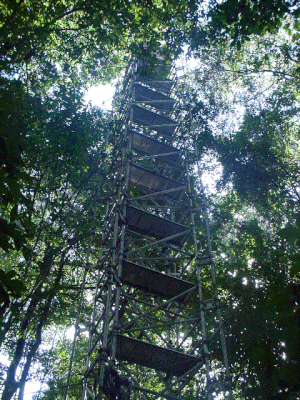Caxiuanã National Forest
| Caxiuanã National Forest Floresta Nacional de Caxiuanã |
|
|---|---|
|
IUCN category VI (protected area with sustainable use of natural resources)
|
|

Meteorological station, Caxiuanã National Forest
|
|
| Coordinates | 1°47′32″S 51°26′03″W / 1.792306°S 51.434028°WCoordinates: 1°47′32″S 51°26′03″W / 1.792306°S 51.434028°W |
| Area | 300,000 hectares (740,000 acres) |
| Designation | National forest |
| Established | 1961 |
| Governing body | Chico Mendes Institute for Biodiversity Conservation |
Caxiuanã National Forest (Portuguese: Floresta Nacional de Caxiuanã, also FLONA de Caxiuanã) is a national forest located in lower Amazon region the state of Pará in the North Region of Brazil. It is located on the west banks of the Baía de Caxiuanã between the Xingu River and downstream from the Anapu River. The forest is located southeast of the Ilha do Marajó. Caxiuanã National Forest covers two municipalities in Pará, Portel (population: 47,967) and Melgaço (population: 25,153), but the forest itself is sparsely inhabited. It is located 400 kilometres (250 mi) from the state capitol of Belém.
Caxiuanã is noted for its rich biodiversity, geographic isolation, and a very low population density. The national forest is the oldest in Amazônia Legal, a region that contains all 9 states in the Amazon Basin, and is also the second oldest national forest in Brazil.
Hearings on logging in Caxiuanã National Forest, part of a nationwide campaign to grant logging concessions in national parks by the Brazilian Forest Service (Serviço Florestal Brasileiro, SFB), began in 2014. A proposal calls for the logging of 1,800 square kilometres (690 sq mi) in three areas of Caxiuanã.
Caxiuanã National Forest was established on November 28, 1961, under federal law No. 239. It is managed by Chico Mendes Institute for Biodiversity Conservation (ICMBio), which maintains two bases in the forest. The Ferreira Penna Scientific Station (Estação Científica Ferreira Penna) is maintained by the Museu Paraense Emílio Goeldi and Brazilian Institute of Environment and Renewable Natural Resources (Instituto Brasileiro do Meio Ambiente e dos Recursos Naturais Renováveis, IBAMA), and is the center of many international research projects. The research station covers 330 square kilometres (130 sq mi), opened in 1993, and consists of laboratories and housing.
...
Wikipedia

